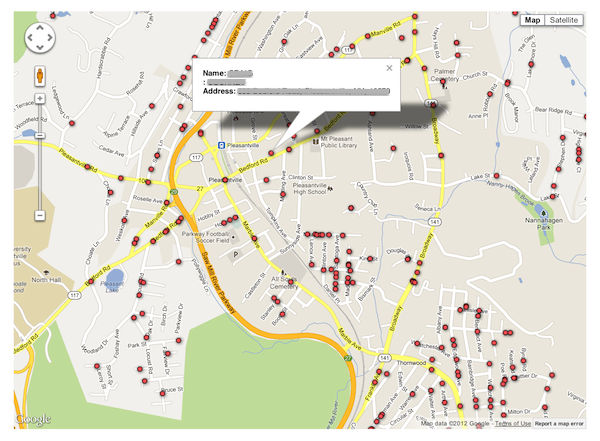
Here’s a parting story from 2012 that I think sets the stage for a major theme of 2013: data has power.
Last week a newspaper in New York published an interactive map of gun permit owners in Westchester and Rockland counties. It made it effortless for anyone to see who has a gun permit in their neighborhood, with names and addresses.
While this is not the first time such information has been put online, this particular incarnation was a perfect storm with an easy interface (thank you, Google Maps), distribution with an emotional accompanying story, and a viral wildfire in social media at the exact moment when advocates on both sides of the gun control debate are on high alert.
Controversy promptly ensued, from CNN to TechCrunch. An angry blogger in turn posted the names and home addresses — and in some cases phone numbers, Facebook pages, and other personal details — of every staff member on the paper he could find.
For the purposes of this post, let’s set aside the rabid brawl over gun control. This is a blog about marketing and technology, not politics or public policy. The facet of this story that I want to call attention to is the incredible impact that this data had when presented with a highly usable visualization in a highly relevant context.
See, the data about gun permit owners was already — technically — public information. But aggregating that information and putting it into a compelling visualization — and associating that with crimes committed with guns — made a powerful story. It also enraged many people who considered it a “violation of their privacy.”
Yet how could it have been a violation of privacy if the information was already a matter of public record?
The reality was that the barriers to acquiring that information before — filing Freedom of Information Act (FOIA) requests with different local bureaucracies — were high enough to dissuade, well, pretty much everyone. Getting that data, processing it, and then turning it into something useful was either too much work or something that no one had really imagined doing before. So while technically it was public information, for all practical purposes, it might as well have been private. (Those of you with reams of data buried in silos throughout your organization can surely relate.)
Taking that “public” data hidden in the bowels of government and making it readily viewed by anyone with an Internet connection therefore felt like a huge change to the status quo.
In the same vein, I’m not sure how many of the names and addresses of the newspaper’s staff were in the public domain already, but I suspect that most of that information was already out there — as that’s how that angry blogger found it. But by putting that information in the context of this story, he clearly was encouraging people to inundate them with, um, opinionated feedback. En masse.
I’m not morally equating these two moves. My point is that the collection, organization, and sharing of previously obscure data on both sides had a powerful effect.
Circling back to the realm of marketing technology, I think there are two important takeaways for marketers:
First, the difference between data and applied data is huge. Marketers collect a ton of data these days, and they have access to even more through a myriad social networks, audience data exchanges, the public domain, etc. The challenge is now how to effectively apply that data to making a positive impact on customers and business management. This isn’t just about “big data” either. Note that the datasets used in this story — the gun permits and the newspaper’s staff — were both small. But the right data, in the right context, presented in the right application can be incredibly persuasive.
Second, the more data is applied, the more people will care about privacy. Most people haven’t paid any attention to privacy policies and terms of service. But that is likely to change as data is increasingly turned into applied data. Even if your use of data is modest and respectful, more and more stories of data abuse will certainly raise concerns. More people will care about exactly what data you collect from them and why. While you can deliver some amazing new features to customers using data well, keep in mind that one person’s feature might be another person’s fear. (Take the Instagram brouhaha from a couple of weeks ago as another example.)
As the superhero motto goes, with great power comes great responsibility.



